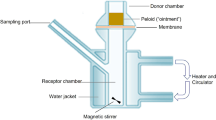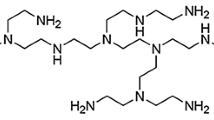Abstract
Although electrically assisted transdermal drug delivery has recently achieved a great deal of research attention, the precise anatomical pathway followed by these drugs through the stratum corneum has not been clearly defined. Pigs are an accepted model for studying iontophoretic drug delivery in humans. The purpose of this investigation was to visualize the pathway of ion transport by iontophoresing mercuric chloride. Weanling Yorkshire swine were dosed with 7.4% mercuric chloride in the positive electrode at a current density of 200 µAmp/cm2 applied for 1 hr. Biopsies were immediately taken, exposed to 25% ammonium sulfide vapor to precipitate and localize the mercury, fixed, and processed for light and transmission electron microscopy. The presence of mercury, which appeared as a black precipitate, was confirmed using energy-dispersive X-ray microanalysis. Although some compound penetrated the skin through appendageal pathways, the electron micrographs clearly revealed that mercuric chloride traversed the intact stratum corneum via an intercellular route. Precipitate was also localized in the outer membrane of the mitochondria in the viable epidermal cells, dermal fibroblasts, and capillaries, demonstrating transdermal delivery and systemic exposure to the mercury. These findings have implications for iontophoretic drug delivery, since they allow visualization of the functional “pores” predicted by mathematical models.
Similar content being viewed by others
REFERENCES
H. E. Bodde, F. H. N. de Haan, L. Kornet, W. H. M. Craanevan Hinsberg, and M. A. Salomons. Transdermal iontophoresis of mercuric chloride in vitro: electron microscopic visualization of pathways. Proc. Int. Symp. Control. Rel. Bioact. Mater. 18:301–302 (1991).
C. Cullander and R. H. Guy. Sites of iontophoretic current flow into the skin: Identification and characterization with the vibrating probe electrode. J. Invest. Dermatol. 97:55–64 (1991).
R. R. Burnette and B. Ongpipattanakul. Characterization of the pore transport properties and tissue alteration of excised human skin during iontophoresis. J. Pharm. Sci. 77:132–137 (1988).
N. A. Monteiro-Riviere. Altered epidermal morphology secondary to lidocaine iontophoresis: in vivo and in vitro studies in porcine skin. Fundam. Appl. Toxicol. 15:174–185 (1990).
R. L. Bronaugh, R. F. Stewart, and E. R. Congdon. Methods for in vitro percutaneous absorption studies. II. Animal models for human skin. Toxicol. Appl. Pharmacol. 62:481–488 (1982).
N. A. Monteiro-Riviere. Comparative anatomy, physiology and biochemistry of mammalian skin. In D. W. Hobson (ed.), Dermal and Ocular Toxicology: Fundamentals and Methods, CRC Press, Boca Raton, FL, 1991, pp. 3–71.
H. E. Bodde, I. van den Brink, H. K. Koerten, and F. H. N. J. de Haan. Visualization of in vitro percutaneous penetration of mercuric chloride: Transport through intercellular space versus cellular uptake through desmosomes. Control. Release 15:227–236 (1991).
H. H. Sharata and R. R. Burnette. Effect of dipolar aprotic permeability enhancers on the basal stratum corneum. J. Pharm. Sci. 77:27–32 (1988).
M. K. Nemanic and P. M. Elias. A novel cytochemical technique for visualization of permeability pathways in mammalian stratum corneum. J. Histochem. Cytochem. 28:573–578 (1980).
A. Lundstrom and T. Egelrud. Cell shedding from human plantar skin in vitro: Evidence of its dependence on endogenous proteolysis. J. Invest. Dermatol. 91:340–343 (1988).
A. Lundstrom and T. Egelrud. Evidence that cell shedding from plantar stratum corneum in vitro involves endogenous proteolysis of the desmosomal protein desmoglein I. J. Invest. Dermatol. 94:216–220 (1990).
D. C. Swartzendruber, P. W. Wertz, D. J. Kitko, K. C. Madison, and D. T. Downing. Molecular models of the intercellular lipid lamellae in mammalian stratum corneum. J. Invest. Dermatol. 92:251–257 (1989).
K. C. Madison, D. C. Swartzendruber, P. W. Wertz, and D. T. Downing. Presence of intact intercellular lipid lamellae in the stratum corneum. J. Invest. Dermatol. 88:714–718 (1987).
G. K. Menon, K. R. Feingold, and P. M. Elias. Lamellar body secretory response to barrier disruption. J. Invest. Dermatol. 98:279–289 (1992).
Author information
Authors and Affiliations
Rights and permissions
About this article
Cite this article
Monteiro-Riviere, N.A., Inman, A.O. & Riviere, J.E. Identification of the Pathway of lontophoretic Drug Delivery: Light and Ultrastructural Studies Using Mercuric Chloride in Pigs. Pharm Res 11, 251–256 (1994). https://doi.org/10.1023/A:1018907508501
Issue Date:
DOI: https://doi.org/10.1023/A:1018907508501




